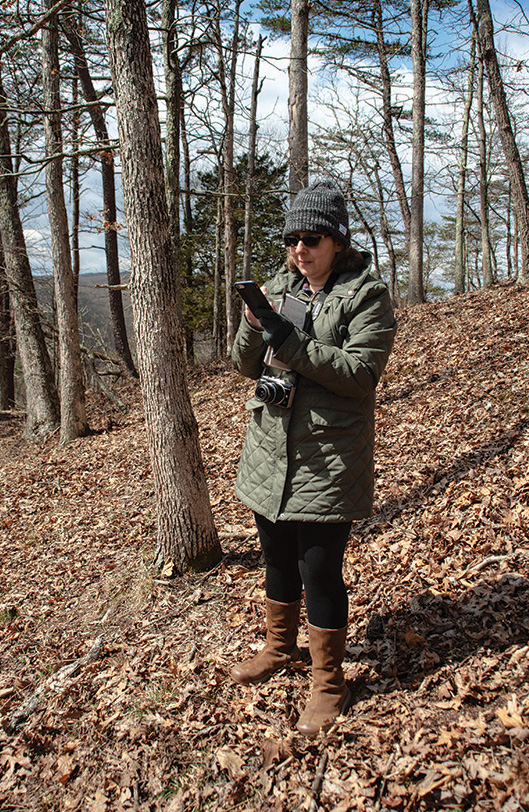Seeing the Chesapeake through the Forest
By Rona Kobell

Editor Rona Kobell posts on our social media accounts from a Western Maryland
forest. Photograph, Nicole Lehming
I’m going to Western Maryland. I’m doing a Chesapeake Bay story.” As soon as I said it, I realized my 13-year-old was flummoxed. Did I need a map? Didn’t I know that was the wrong direction?
The fact is, in 14 years of writing about the Chesapeake Bay — for The Baltimore Sun, then the Bay Journal, and now this magazine — I only went to Western Maryland twice. And once was for a story relating to a military unit in the Iraq war.
But the forests, streams, and air west of Hagerstown have important stories to tell about the Bay — stories that will help us restore the health of the estuary, and help us better connect to the people who live 200 miles from it. This issue of Chesapeake Quarterly looks at some of those stories, many of which come from work done at the University of Maryland Center for Environmental Science’s Appalachian Laboratory next to Frostburg University. There, ecologist Andrew Elmore is examining how a decrease in nitrogen oxide pollution in the air — unquestionably a good development — is allowing forests to grow leaves earlier, and what that means for species that depend on forest habitat. Elmore is also looking at buried streams, mapping all of these now-hidden waterways in the Potomac River basin and encouraging federal officials to do the same nationwide to prevent flooding.
The lab is reaching out to residents around Frostburg for citizen-science projects and public education. One effort, Watershed Moments, brought dozens of residents to the lab one evening to learn about the macro-invertebrates that live in streams.
The lab is involved in other fascinating research under the leadership of director Eric Davidson, current president of the American Geophysical Union. Katia Engelhardt, a wetland ecologist, is working with a University of Maryland, College Park plant geneticist, Maile Neel, to determine the genetic biodiversity of a Chesapeake Bay grass species and how it responds to varying water clarity. And ecologist Robert Hilderbrand dives into the mysterious world of Didymo, a world-traveling algae that has appeared in Maryland streams.
Also upstream from the Bay, but not quite as far: our newest extension agent, Kelsey Brooks, is focused on engaging residents in Harford, Baltimore, and Carroll Counties on matters of clean water. She just started the newest Watershed Stewards Academy in Bel Air, Maryland. So while Western Maryland might not be near the Chesapeake, it is definitely of it. After all, everyone lives upstream from somewhere.
—Rona Kobell |